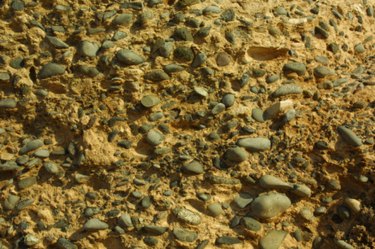Things You'll Need
One pound of soil
Four sieves (0.01 mm, 0.1 mm, 1.0 mm, 10 mm) with connecting latches
Digital scale (up to 1 pound capacity)
Calculator

An effective particle size refers to the effective optical size of a particle and is defined as the average diameter of the sphere. However, many particles are non-spherical and difficult to accurately measure. This problem is evident in soil particle distribution methods. The determination of an effective particle size in soils is crucial when determining flow rates, porosity and settling velocity. These parameters assist civil engineers when designing dirt structures such as temporary dams or foundations. Effective particle size can be determined using sieves.
Step 1
Arrange the sieves one on top of the other beginning with the 10 mm sieve on top and the 0.01 mm sieve on the bottom. The sieves should be secured to one another with the latches to prevent coming apart.
Video of the Day
Step 2
Pour the dirt until the top sieve (10 mm) is filled and shake all four sieves for 10 minutes. The one pound of soil should fill the entire sieve with none left over. Ensure that there are not agglomerated soil pieces (dirt clods).
Step 3
Unlatch all four sieves and weigh the dirt that remains in each sieve. The values recorded will generate an average (effective) particle size distribution. For instance, if there is 0.2 pound of soil in each sieve and 0.2 pounds of soil from the very bottom of the smallest sieve, then it is assumed that 20% of the sizes are larger than 10 mm, 20% are between 1 and 10 mm, 20% are between 1 and 0.1 mm, 20% are between 0.1 and 0.01 mm and 20% are smaller than 0.01 mm. Taking the average of this yields an effective particle size of 3.67 mm.
Video of the Day